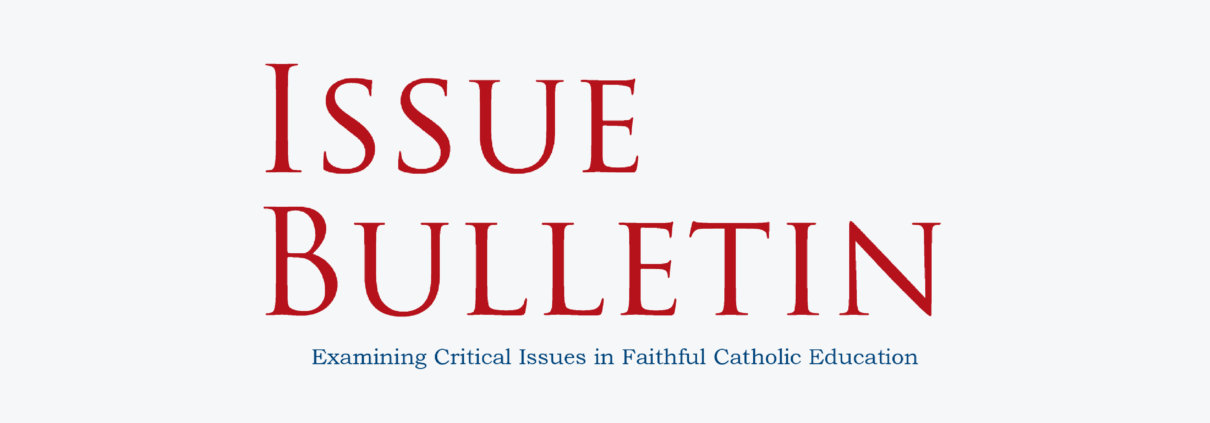Common Core Assessments May Be Cost-Prohibitive for Catholic Schools
This is part of a series of reports on the Common Core State Standards Initiative and its potential impact on Catholic education.
Of key importance to parochial, private, and public school administrators and superintendents is the question of how to address the costs associated with the technological requirements for assessing students under the new Common Core State Standards (CCSS). Looking into what is being asked of schools by the two companies producing the CCSS assessments, one quickly sees that the expense associated with implementation of the new evaluation instruments is in excess of hundreds of thousands of dollars. In addition to the cost of training teachers and purchasing the testing materials, school districts and private schools that choose to use Common Core Standards will find hardware costs taking a significant chunk out of their operating budgets.
Cost Drivers
The Partnership for Assessment of Readiness of College and Careers (PARCC) and the Smart- er Balanced Assessment Consortium are both designing assessments for use with computers that have at least one gigabyte of memory and a screen display of 9.5 inches (10-inch class) at a resolution of 1,024 X 768 or greater (Norris & Soloway, 2013). For optimal use, Smarter Balanced recommends at least an 80-GB hard drive or at least one GB of hard drive space be made available (Smarter Balanced, 2013a). These requirements eliminate popular Netbooks and iPad minis or any of the new versions that have display sizes smaller than the required 9.5 inches. Smarter Balanced recommends the iPad 3+ running iOS6 (Smarter Balanced, 2013a).
Additionally, many of the school systems and private schools are falling short of the recom- mended hardware-to-student ratio of 1:6-7 (Kantrowitz, 2013; Davis, 2012). While there may be adequate technology available for Internet access, the support systems may be outdated or not compatible with the new assessment software. For example, the testing software is not able to run on Microsoft XP systems. Thus these popular, well-functioning computers are not eligible for use with tests for this particular assessment. Some states may initially choose to continue to use paper and pencil for their annual high-stakes tests, but this will not be an op- tion for schools that choose advanced techniques to master the Common Core assessments.
Inadequate bandwidth can also rule out some eligible computers and schools. At a minimum, additional bandwidth will be required along with the associated costs to enable simultaneous testing of multiple grades and sections. What happens when not enough money is available? Will there be a divide between the “haves” and the “have nots?” Who gets the new tests and other tools necessary to properly prepare students for these assessments? How will these af- fect issues of adequacy and equity? Will the lack of technology create a bigger achievement gap?
Of concern to administrators is the degree of technology dependence that has occurred throughout most programs associated with all schools. This reliance is evident and necessary, as there can be as many as five different tests administered within the year. PARCC is developing three separate diagnostic tests (reading, writing, and mathematics) and both a mid-year and end-of-year assessment. In addition, two other performance tests associated with speech and listening are in the development stages (Partnership for Assessment of Readiness of College and Careers, 2013). Smarter Balanced has similar requirements with both an interim and end of year assessment. Needs are enhanced when there is a quick turnaround time for school administrators and teachers to receive results, analyze them, and implement necessary instructional changes and interventions. In addition to student assessment, assessments will also be attached to some teacher evaluations whose deadlines vary throughout the year.
Teachers, as well as students, will need to become proficient on the use of testing software so that these variables are minimized when students are testing. Nuances include kindergarten students being required to respond through a keyboard and students in grades four to five asked to type their responses in a minimum one-to two-page document (Carr & Dreilinger, 2013). Time and money will need to be allocated toward teacher and student proficiency in online test-taking skills prior to any testing.
The per-pupil cost for PARCC assessments is quoted to be between $22.50 to $29.50, which is one reason why Florida opted out of these assessments (Chieppo & Gass, Aug. 15, 2013; Kantrowitz, October 15, 1013). Georgia withdrew from PARCC, citing skyrocketing cost and loss of local control. The GADOE intends to develop its own in-state tests aligned to Com- mon Core standards and is looking to other states to form possible partnerships in this development (Shearer, July 22, 2013). Smarter Balanced tests are estimated to run from $22.50 to
$27.30, including scoring services (Smarter Balanced, 2013b). According to Jacqueline King, Ph.D., (email communication, November 2013) private schools interested in participating in the Smarter Balanced testing option must be located in a state that is working with Smarter Balanced. Each state Department of Education has the option as to whether this arrangement exists.
Alternate Testing Possibilities
Options to the PARCC assessments include the new Aspire test being field tested by ACT. Scheduled for release in April 2014, Aspire was recently adopted by the state of Alabama (Stacey, 2013; ACT, personal communication, October 17, 2013). This test will eliminate concerns about having to purchase computer software and hardware, as it offers an option of pencil and paper administration. For scoring, schools can either mail in assessments with a turnaround time of 4-6 weeks or submit immediately through online access. Aspire is being developed only for grades 3-8 and early high school (9th/10th grade). It is aligned to the Common Core Standards, and the reports will be coded to the pre-existing 1-36 scale of college readiness already used for the ACT exam. Per-pupil cost has yet to be released, but one can sign up on the ACT Website to receive immediate updates about the test’s release. Subject area exemplars are given on the website, and Common Core skills are evident, especially in the math exemplars where questions are asked as to how the student arrived at his or her answer. At this time, ACT has not released how or who will grade these student self-response items, or if there is a local grading option. This test is available on the open market and not restricted to states that have signed on to one of the national testing consortia.
Private-school administrators who currently use the Iowa Test of Basic Skills may consider upgrading to Iowa Form E. Form E is the newest edition to the assessment suite of Iowa tests and was developed in 2010, before the Common Core Math and Language Arts Standards were finalized (Michele Baker, personal communication, Sept. 17, 2013). Norming for the 2010 Form E was performed in 2011, before most schools fully implemented CCSS. New norms for Form E can be expected every five years and according to Michele Baker, Senior Assessment Consultant for Riverside Publishing, Houghton Mifflin Harcourt, Form E will probably be available for 10 years or longer, at which time a newer edition will be released along with a new set of norms. By purchasing the Form E or Form F version (a parallel version in development) of the Iowa assessments, administrators would have the newest test based on pre-CCSS norms and full implementation.
Currently, Iowa Assessments have a turnaround time of about two weeks. When tests are given in the fall (generally late September or early October) using a prescriptive approach for learning, it is not until November, after the administration reviews test results, that teachers are able to make classroom instructional changes. By this time, 40 percent of the school year has passed. With the new Iowa Form E assessment, a quick turnaround is now a possibility with the use of DataManager. This program is a robust online reporting system that provides administrators and teachers with almost immediate online reports. While learning the system and how to request the reports might be a little time-consuming, anyone who has been granted access can generate a student report. The Iowa Form E has also been aligned to the Common Core with a report option to print out a typical or traditional report, instead of the CCSS report. This is beneficial for schools that may be in transition to new standards or that are waiting until the “dust has settled” before deciding to implement the CCSS. Students can test in the traditional pencil and paper format, or the school can use an online computer testing option. The per-pupil cost ranges from $7.43 to $10.08 for full DataManager reporting services, with an additional $3.00 for the Cognitive Abilities Test (Michele Baker, personal communication, September 17, 2013). An additional benefit of using the Iowa tests is the use of standard scores students receive on Iowa tests, which have been validated and found to have a strong relationship with ACT college benchmark scores for college readiness (University of Iowa, n.d).
Private schools can also continue using the reasonably priced Stanford 10 for annual assessments. These assessments were developed from a variety of professional organizations (International Reading Association, National Council of Teachers of English, National Council of Teachers of Mathematics) and were normed in 2007, prior to CCSS. The Stanford 10, Form A has been aligned to the CCSS. The cost is between $7.78 and $9.28 per student test with answer sheets costing $2.00 each.
It seems that for parochial, private, and public schools that are committed to any of the testing consortia, little can be done to escape the costs and time necessary for technology upgrades and teacher and student training. For schools that are considering the CCSS assessment options and are in states governed by one of the consortia, considerations including computer upgrades, additional per-pupil testing costs, and possible additional testing time need to be budgeted and allotted. Additional time is also required to train the students and teachers on the test-taking. Until the impact of the CCSS initiative along with the newly designed testing instruments is realized, and in consideration of the research reported on this topic, schools can find a safe haven, at least for the time being, in the Iowa Forms E & F and Stanford 10 traditional assessments.
References
Carr, S. & Dreilinger, D. (September 29, 2013). “A Core dilemma: Will the littlest learners be able to type?”, The Hechinger Report. Retrieved from http://hechingerreport.org/content/a- core-dilemma-will-the-littlest-learners-be-able-to-type_13198.
Chieppo, C. & Gass, J. (August 15, 2013). “Why states are backing out on common core standards and tests,” The Hechinger Report. Retrieved from http://hechingerreport.org/content/ why-states-are-backing-out-on-common-standards-and-tests_12895.
Davis, M. (2012). “Are You Tech-Ready for the Common Core?”, Education Week. Retrieved from www.edweek.org/dd/articles/2012/10/17/01readiness.h06.html?tkn=NVZFOAfSykw%2BRxSo395jo6lu%2FANympkgfH41&print=1.
Kantrowitz, B. (October 15, 2013). “Testing the Common Core in Tennessee,”The Hechinger Report. Retrieved from http://hechingerreport.org/content/testing-the-common-core-in-ten- nessee_13468.
Norris, C., & Soloway, E. (2013). “Common Core Technological Standards: They Are the Tail, Not the Dog,” The Journal. Retrieved from http://thejournal.com/Articles/2013/01/14/ Common-Core-Technological-Standards.aspx?p=1.
Partnership for Assessment of Readiness of College and Careers (2013). PARCC Test Administration Policies. Retrieved from www.PARCConline.org.
Shearer, L. (July 22, 2013). “Georgia will drop out of Common Core-aligned testing consor- tium.” Retrieved from http://onlineathens.com/local-news/2013-07-22/georgia-will-drop- out-common-core-aligned-testing-consortium.
Smarter Balanced Assessment Consortium (February, 2013a). “Hardware and Software Requirements Overview.” Retrieved from http://www.smarterbalanced.org/wordpress/wp-content/uploads/2011/12/Executive_Summary_Tech_Framework.pdf.
Smarter Balanced Assessment Consortium (2013b). “Frequently Asked Questions.” Retrieved from http://www.smarterbalanced.org/resources-events/faqs/.
Stacey, E. (February 13, 2013). “Alabama Exits National Common Core Tests.” Retrieved from http://news.heartland.org/newspaper-article/2013/02/13/Alabama-exits-national-common-core-tests.
University of Iowa (n.d.). “Tracking Growth towards Readiness with the Iowa Tests.” Retrieved from https://itp.education.uiowa.edu/ia/documents/Assessment-Brief-Readiness- Final.pdf.



 St. Agnes School, St. Paul, MN
St. Agnes School, St. Paul, MN 


